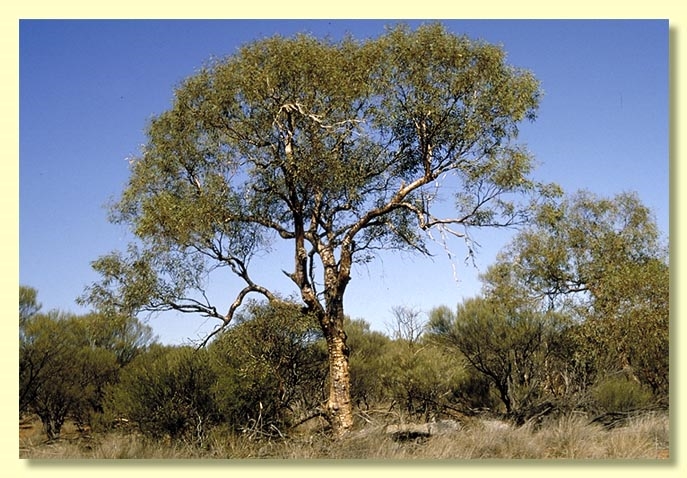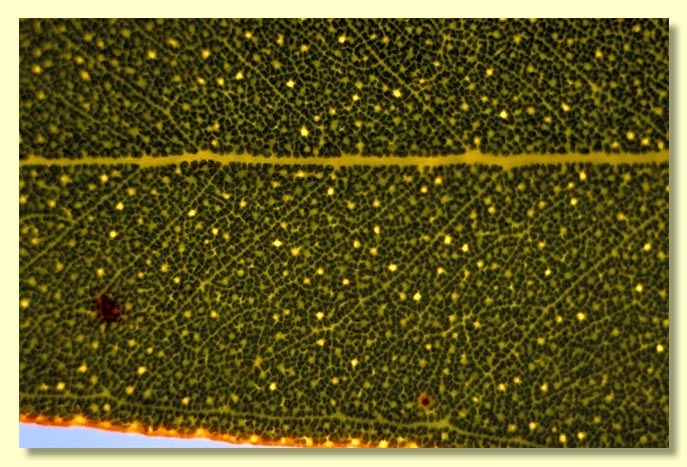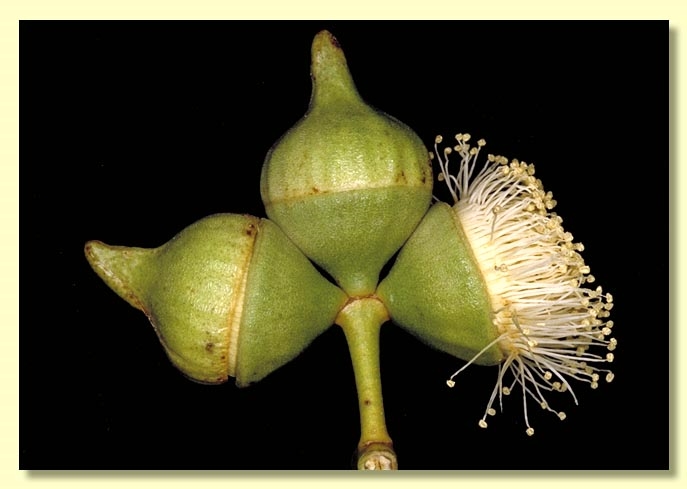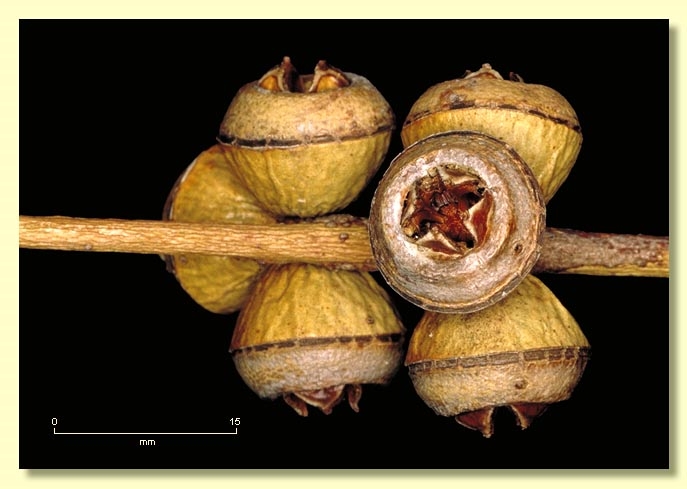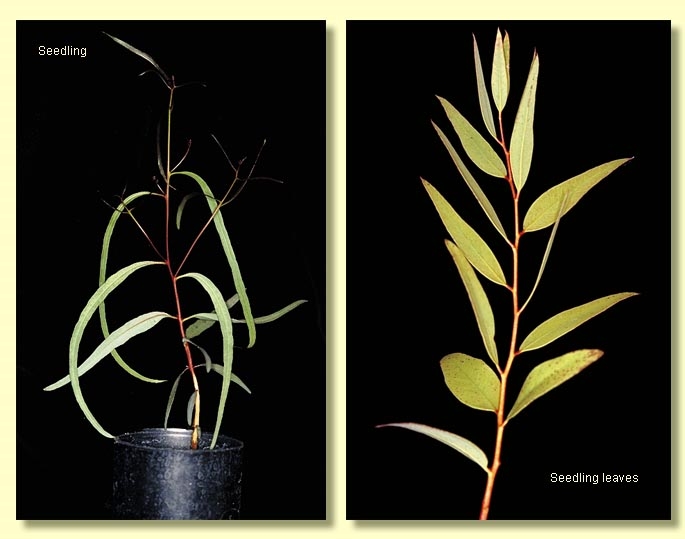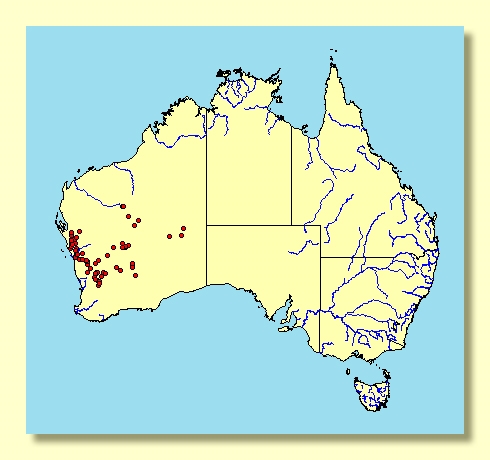Eucalyptus | Symphyomyrtus | Bisectae | Destitutae | Curviptera | Xylocarpae
Euclid - Online edition
Eucalyptus oldfieldii
T: Murchison R., W.A., A.Oldfield s.n.; syn: K, MEL, U, W.
Bark rough with semi-persistent broad grey-brown to black ribbons loosely sheathing part or all of trunk extending sometimes to limbs ca 5 cm diameter, or stems smooth throughout, grey and brown mottled.
Branchlets lacking oil glands in the pith.
Juvenile growth (coppice or field seedlings to 50 cm): stems rounded in cross-section; juvenile leaves petiolate, alternate, ovate to broadly lanceolate, 6–12 cm long, 1–3.5 cm wide, dull, green-grey.
Adult leaves alternate, petioles 1.2–2.8 cm long; blade narrowly lanceolate to lanceolate, 6.3–11.5 cm long, 0.9–2.5 cm wide, base tapering to petiole, margin entire, apex acute, concolorous, dull, green to greyish green, side-veins at an acute or wider angle to midrib, reticulation dense to very dense, intramarginal vein close to margin, oil glands intersectional.
Inflorescence axillary unbranched, peduncles 0.1–1.1 cm long, buds 3, rarely 7, sessile or pedicellate, pedicels 0–0.5 cm long. Mature buds globular to squatly obovoid, sometimes with shallow longitudinal ribs (1.2–2.2 cm long, 0.9–1.5 cm wide), scar present, operculum rounded to flat-topped with prominent beak, or the beak rarely absent (0.7–1.3 cm long), stamens oblique, anthers cuboid, versatile, dorsifixed, dehiscing by longitudinal slits, style long and straight, stigma blunt to rounded, locules (3)4 or 5, the placentae each with 4 vertical rows of ovules but with a central gap. Flowers white.
Fruit sessile or pedicellate, pedicels 0–0.4 cm long, broadly and shallowly obconical to cupular or hemispherical, 0.5–1.2 cm long, 1–2 cm wide, disc raised oblique, usually convex, sometimes flat, rarely concave, valves (3)4 or 5, exserted.
Seeds brown to pale grey-brown, 1.5–3 mm long, pyramidal to obliquely pyramidal or more or less cuboid, always ridged, sometimes with a narrow partial marginal flange, dorsal surface shallowly reticulate, hilum terminal.
Cultivated seedlings (measured at node 10): cotyledons Y-shaped (bisected); stems rounded in cross-section; leaves always petiolate, opposite for 3 to 7 nodes, early leaves lanceolate but becoming narrower at alternation, especially in some inland populations, generally they are linear to falcate or narrowly lanceolate at node 10, 6–17 cm long, 0.5–2 cm wide, dull, green.
Flowering has been recorded in April, July, August, September and October.
A mallee or small tree endemic to Western Australia, widespread north and north-east of Perth, to near Shark Bay and east to the south of Warburton. The bark is rough over the base of the stems or trunk in most areas, although the tree form east of Shark Bay is completely smooth. The adult leaves are dull, blue-grey to grey-green.
Eucalyptus oldfieldii belongs in Eucalyptus subgenus Symphyomyrtus section Bisectae subsection Destitutae because buds have two opercula, cotyledons are Y-shaped and branchlets lack oil glands in the pith. Within this subsection E. oldfieldii is in series Curviptera, one of about 30 closely related species and subspecies which are further characterised by having large buds in umbels of one, three or seven, staminal filaments erect or oblique (rarely inflexed) in bud, and large fruit usually with an ascending disc and exserted valves.
E. oldfieldii, with its beaked buds in umbels of three, large cupular-obconical fruit with steeply ascending oblique to convex disc and pyramidal seed, is most closely related to and most likely to be confused with E. burracoppinensis.
Seedling leaves in some arid zone populations of E. oldfieldii, e.g. near Warburton, Cosmo Newberry and further north at Savoury Creek, are often long and linear, and plants from these areas may ultimately prove to be a different species or subspecies.

